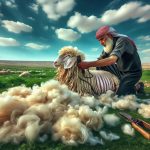Wool comes from animals like sheep, goats, and bison. Wool yarn is made from wool fibers found in sheep fleece. Wool is raw and natural, while yarn is processed into thread. Wool is the base material used for crafting. Yarn is the spun form favored in various projects. Merino wool is prized for its softness. Yarn can have different twists. Wool comes in various types like fleece and locks. Sheep's wool is known for warmth. If you want to explore further, there's more to discover about the characteristics and differences between wool and wool yarn.
Table of Contents
Key Takeaways
- Wool is the raw natural fiber from animals, while wool yarn is the spun thread form of wool fibers.
- Wool serves as the base material for crafting, whereas wool yarn is the processed form used in crafting projects.
- Merino wool is known for fine fibers and softness, while yarn can have different twists like S-twist or Z-twist.
- Wool comes in types like fleece, broken pieces, bellies, and locks, while yarn offers color options and textures.
- Quality-wise, sheep's wool is valued for softness and warmth, while crafters' yarn provides varied colors and textures.
Wool Vs. Wool Yarn: Overview
When comparing wool and wool yarn, it's important to distinguish the natural hair from animals like sheep and the specific yarn spun from wool fibers. Wool, originating mainly from sheep like the prized Merino sheep, refers to the soft hair that covers these animals. On the other hand, wool yarn specifically denotes the yarn crafted by spinning wool fibers obtained from the fleece of these sheep.
Merino sheep are well-known for producing wool that's incredibly soft, fine, and luxurious, making it highly sought after in the textile industry. This quality wool is then transformed into wool yarn through a spinning process, resulting in a versatile material used for various crafts such as knitting, weaving, and more.
Understanding the distinction between wool and wool yarn is important for individuals engaging in textile projects as it helps in selecting the appropriate material based on the specific requirements of the project. The journey from the natural fiber of wool to the spun yarn opens up a world of creative possibilities in the domain of crafting.
Natural Fiber Vs. Spun Yarn
In understanding the difference between wool and wool yarn, it's important to distinguish the natural fiber, such as wool sourced from animals like sheep, from the spun yarn created by combining fibers together.
Wool, as a natural fiber, is directly obtained from animal fleece, whereas wool yarn is the product of spinning various fibers together. Wool comes from animals like sheep, goats, and bison, while wool yarn can be crafted from a mix of natural and synthetic fibers.
The key disparity lies in the sourcing of the material: wool is derived from animal fleece, while wool yarn is the result of spinning fibers into yarn. In essence, wool serves as the raw material sourced from animals, while wool yarn is the spun thread formed by amalgamating different fibers.
Understanding this contrast between natural wool fiber and spun yarn is fundamental in appreciating the diverse applications and characteristics of both wool and wool yarn.
Raw Material Vs. Processed Form
Derived from animals like sheep, wool serves as the raw, natural fiber, while wool yarn represents its processed form spun into thread for various crafting purposes. Wool is the unrefined material obtained through shearing and cleaning the fleece of animals like sheep. In contrast, wool yarn is the refined and twisted version of wool, created through spinning the raw fibers into a continuous strand suitable for knitting or weaving projects.
The difference between wool and wool yarn lies in their state and utility. Wool retains its natural properties, such as warmth and softness, making it a sought-after material for crafting cozy and durable items. On the other hand, wool yarn is specifically tailored for textile production, offering a versatile and easy-to-use form of wool for knitting and crocheting enthusiasts. The transformation from raw wool to spun thread involves a meticulous process of cleaning, spinning, and twisting, enhancing the wool's usability and appeal in the crafting world.
Animal Fiber Vs. Crafting Material
Obtaining wool from animals like sheep, goats, and bison provides a natural animal fiber that serves as the foundation for crafting versatile and durable materials. When examining the difference between wool and wool yarn, it's crucial to comprehend the various types of wool available and how they contribute to crafting projects.
Here are some key points to ponder:
- Wool is derived: Wool is harvested by shearing animals and processing their fleece to obtain the raw material for crafting.
- Yarn made: Wool yarn is the spun form of wool, crafted by spinning wool fibers together to produce a continuous strand for knitting and crafting.
- Difference between wool: Wool serves as the base material, while wool yarn is the processed form used in crafting projects.
- Types of wool: Wool yarn can be made from different varieties of wool like merino, cashmere, and alpaca, each offering unique textures and properties for various crafting needs.
Understanding these distinctions can assist you in selecting the right material for your next knitting or weaving project.
Sheeps Coat Vs. Crafting Supply
I love how a sheep's coat provides such soft and warm fleece, perfect for creating cozy wool yarn.
Using wool yarn for knitting allows me to craft beautiful items with unique textures and patterns.
The benefits of wool crafting are endless, from its durability to its natural insulation properties.
Sheeps Fleece Properties
Sheep's fleece properties play an essential role in determining the quality and characteristics of wool yarn used in various crafting projects. Here are some key points to keep in mind:
- The fleece of sheep provides the raw material for wool fiber, influencing the texture of the yarn.
- Different sheep breeds produce fleece with varying qualities, affecting the overall texture and feel of the yarn.
- The natural oils in sheep's fleece, like lanolin, contribute to the softness and water resistance of wool yarn.
- The quality of wool yarn is dependent on the sheep's fleece properties, including fiber length, strength, and color.
Understanding these aspects of sheep's fleece properties can help crafters choose the right wool yarn for their projects.
Yarn for Knitting
Crafting with wool yarn offers a versatile and traditional approach to creating cozy garments and accessories for various knitting projects. Wool yarn is spun from the soft hair of animals like sheep, goats, or alpacas, with sheep's wool being a popular choice due to its quality and texture.
Merino wool, known for its softness and warmth, is a favored type of wool yarn among knitters. Different breeds of sheep produce varying qualities of wool, leading to a diverse range of yarn options for crafting.
Wool yarn maintains the natural properties of wool, making it durable and ideal for knitting projects that require both functionality and style. Knitting with wool yarn provides a canvas of textures and colors, enhancing the creativity of crafters.
Wool Crafting Benefits
Exploring the benefits of wool crafting brings to light the distinction between the natural fiber provided by a sheep's coat and the spun form of wool used as a crafting supply. Here are some key advantages of wool crafting:
- Warmth and Softness: Sheep wool, especially Merino wool, offers exceptional warmth and softness, making it ideal for cozy projects.
- Natural Properties: Wool retains natural properties from the sheep, such as breathability and moisture-wicking capabilities.
- Versatile Crafting Material: Yarn and wool allow for the creation of various items like clothing, blankets, and accessories with unique textures and qualities.
- Exploration of Techniques: Crafting with wool yarn enables individuals to explore traditional and modern techniques in knitting and crocheting projects.
Fiber Source Vs. Crafting Medium
When differentiating between wool and wool yarn, it's crucial to understand the distinction between their fiber source and their role as a crafting medium.
Wool, such as merino wool, originates from animals like sheep, goats, and bison, serving as the raw material for various products, including wool clothing.
On the other hand, wool yarn is the result of spinning or bonding wool fibers together, creating different types of twists to form a continuous thread suitable for knitting, weaving, and other crafts.
The core dissimilarity lies in the source of the material: wool as the natural fiber obtained directly from animals and wool yarn as the processed form used in creative projects.
Recognizing this dissimilarity is essential for determining the appropriate material for specific applications, whether opting for the raw fiber itself or the spun thread for crafting endeavors.
Wool Characteristics Vs. Yarn Utility
With its inherent warmth and softness, wool stands out for its natural insulation properties, contrasting yarn's utility primarily focused on knitting, weaving, and crafting. When comparing wool characteristics to yarn utility, several key differences emerge:
- Merino Wool: Known for its fine fibers and exceptional softness, Merino wool is a highly sought-after breed of sheep for producing luxurious yarn.
- Different Types of Twists: Yarn can have different types of twists, such as S-twist or Z-twist, which affect its strength and appearance in the final product.
- How Yarn Is Made: Yarn is made by spinning fibers together into a continuous strand, enabling it to be used in various textile applications.
- Impact of Breed of Sheep: The breed of sheep from which the wool is sourced influences the texture and quality of the wool, which in turn affects the yarn's characteristics and applications.
Understanding these distinctions between wool and yarn is crucial for choosing the right material for specific projects, whether for their inherent properties or crafting needs.
Fiber Form Vs. Textile Application
Wool, as a natural fiber, differs significantly from wool yarn in its application within the textile industry. Wool comes from animal fleece, such as sheep, goats, and bison, while wool yarn is the spun thread derived from these wool fibers.
When wool is sheared from the animal, it's classified into types like fleece, broken pieces, bellies, and locks. One prominent type of wool is merino, recognized for its soft hair and quality. The difference between merino wool and regular wool lies in the fineness and softness of the fibers.
Conversely, wool yarn is used for knitting, weaving, and creating textiles like clothing, blankets, and carpets. While wool is in its natural fiber form, wool yarn is produced by spinning these fibers into threads for textile production. Understanding the difference between wool and wool yarn is important for using them effectively in various textile applications.
Sheep's Wool Vs. Crafters' Yarn
Coming from the natural fleece of sheep, sheep's wool distinguishes itself from crafters' yarn, which is the processed and spun version suitable for various textile projects.
- Quality: Sheep's wool, especially fine Merino wool, is known for its exceptional softness and warmth, making it a luxurious choice for garments. Crafters' yarn, on the other hand, can vary in quality depending on the type of wool and processing methods used.
- Variety: While sheep's wool typically comes in its natural color or can be dyed, crafters' yarn offers a wide range of color options, textures, and weights, including blends with other fibers like acrylic yarn.
- Source: Sheep's wool specifically refers to wool obtained from sheep, whereas crafters' yarn may include wool from various animal sources like alpaca or llama, as well as synthetic fibers like acrylic.
- Processing: Sheep's wool undergoes minimal processing after shearing, while crafters' yarn involves additional steps such as cleaning, carding, spinning, and sometimes blending with other fibers to create versatile yarns.
Fiber Harvested Vs. Yarn Created
Harvested from animals like sheep, goats, and alpacas, wool serves as the natural fiber source for creating wool yarn. The wool obtained from these animals can vary in quality, with fine yarn typically sourced from the bellies and locks of the animal, while coarser fibers, known as carpet wool, are often taken from other areas. Merino wool, known for its softness and elasticity, is a popular choice for producing high-quality yarn. Below is a comparison table highlighting the differences between fiber harvested and yarn created:
| Fiber Harvested | Yarn Created |
|---|---|
| Wool sourced from sheep, goats, alpacas | Yarn spun from wool fibers |
| Varied quality: fine yarn, carpet wool | Consistent quality in the finished product |
| Includes bellies and locks | Uniform texture and thickness |
| Examples: Merino wool | Utilized in textile applications |
Understanding the distinction between the raw material, such as wool, and the final product, like wool yarn, is essential for appreciating the journey from fiber to finished goods.
Wool Production Vs. Yarn Crafting
Engaging in wool production involves the meticulous process of obtaining natural fibers from animals, while yarn crafting focuses on the art of spinning these fibers together to create a single strand of yarn.
- Merino wool: Known for its softness and fine quality, Merino wool is often used in both wool production and yarn crafting due to its luxurious feel.
- Best wool: Wool production aims to extract the best quality fibers from animals like sheep, ensuring that only the finest wool is obtained for further processing.
- Type of wool: Different types of wool, such as lambswool or cashmere, are used in yarn crafting to create unique textures and finishes in the final yarn product.
- Processing methods: Wool production involves intricate steps like shearing, washing, and combing the fleece to prepare it for spinning, whereas yarn crafting focuses on techniques like twisting and plying to create the desired yarn structure.
Frequently Asked Questions
Are Wool and Yarn the Same Thing?
Wool and yarn are distinct; wool refers to natural animal fibre, while yarn is spun thread from various materials. Wool yarn specifically is made from wool fibres, offering warmth and durability. Understanding this helps in selecting materials for projects.
What Is Wool Yarn?
Wool yarn is a versatile fiber spun from animals like sheep, goats, alpacas, and llamas. It retains wool's natural warmth, softness, and breathability. Different sheep breeds offer diverse textures and colors. Wool yarn excels in cold-weather wear and crafts.
Why Do People Call All Yarn Wool?
People commonly refer to all yarn as wool due to regional language variations. This practice may stem from historical influences. Understanding these nuances aids in clear communication. Recognizing the importance of distinguishing helps in grasping fiber properties accurately.
Why Do Americans Call Wool Yarn?
Americans call yarn made from wool 'wool yarn' to specify the material used. It's a common practice here. The distinction helps in understanding the unique qualities of wool yarn. It's just how we refer to it!
- Tetron Fabric for Marine Applications: Durability and Use Cases - June 18, 2025
- Tetron Fabric for Outdoor Furniture: Weather Resistance and Care - June 18, 2025
- Tetron Fabric for Wall Coverings: Style and Application Tips - June 18, 2025







